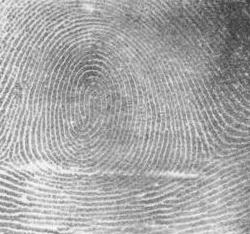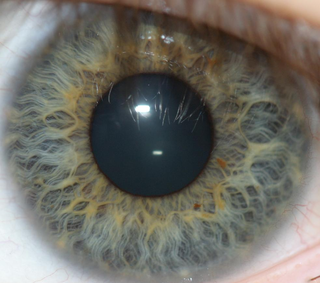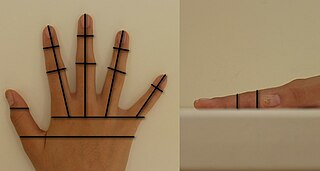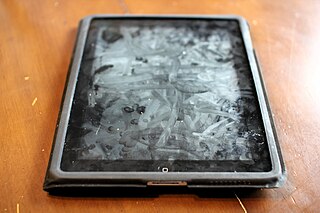Related Research Articles

A fingerprint is an impression left by the friction ridges of a human finger. The recovery of partial fingerprints from a crime scene is an important method of forensic science. Moisture and grease on a finger result in fingerprints on surfaces such as glass or metal. Deliberate impressions of entire fingerprints can be obtained by ink or other substances transferred from the peaks of friction ridges on the skin to a smooth surface such as paper. Fingerprint records normally contain impressions from the pad on the last joint of fingers and thumbs, though fingerprint cards also typically record portions of lower joint areas of the fingers.
Biometrics are body measurements and calculations related to human characteristics. Biometric authentication is used in computer science as a form of identification and access control. It is also used to identify individuals in groups that are under surveillance.

Iris recognition is an automated method of biometric identification that uses mathematical pattern-recognition techniques on video images of one or both of the irises of an individual's eyes, whose complex patterns are unique, stable, and can be seen from some distance. The discriminating powers of all biometric technologies depend on the amount of entropy they are able to encode and use in matching. Iris recognition is exceptional in this regard, enabling the avoidance of "collisions" even in cross-comparisons across massive populations. Its major limitation is that image acquisition from distances greater than a meter or two, or without cooperation, can be very difficult.
A retinal scan is a biometric technique that uses unique patterns on a person's retina blood vessels. It is not to be confused with other ocular-based technologies: iris recognition, commonly called an "iris scan", and eye vein verification that uses scleral veins.
Synaptics is a publicly owned San Jose, California-based developer of human interface (HMI) hardware and software, including touchpads for computer laptops; touch, display driver, and fingerprint biometrics technology for smartphones; and touch, video and far-field voice technology for smart home devices and automotives. Synaptics sells its products to original equipment manufacturers (OEMs) and display manufacturers.

Hand geometry is a biometric that identifies users from the shape of their hands. Hand geometry readers measure a user's palm and fingers along many dimensions including length, width, deviation, and angle and compare those measurements to measurements stored in a file.
A card reader is a data input device that reads data from a card-shaped storage medium. The first were punched card readers, which read the paper or cardboard punched cards that were used during the first several decades of the computer industry to store information and programs for computer systems. Modern card readers are electronic devices that can read plastic cards embedded with either a barcode, magnetic strip, computer chip or another storage medium.

Vein matching, also called vascular technology, is a technique of biometric identification through the analysis of the patterns of blood vessels visible from the surface of the skin. Though used by the Federal Bureau of Investigation and the Central Intelligence Agency, this method of identification is still in development and has not yet been universally adopted by crime labs as it is not considered as reliable as more established techniques, such as fingerprinting. However, it can be used in conjunction with existing forensic data in support of a conclusion.
IDEX Biometrics ASA, is a Norwegian biometrics company, specialising in fingerprint imaging and fingerprint recognition technology. The company was founded 1996 and is headquartered in Oslo, but its main operation is in the US, with offices in New York and Massachusetts. The company also has offices in the UK and China.

A smudge attack is an information extraction attack that discerns the password input of a touchscreen device such as a cell phone or tablet computer from fingerprint smudges. A team of researchers at the University of Pennsylvania were the first to investigate this type of attack in 2010. An attack occurs when an unauthorized user is in possession or is nearby the device of interest. The attacker relies on detecting the oily smudges produced and left behind by the user's fingers to find the pattern or code needed to access the device and its contents. Simple cameras, lights, fingerprint powder, and image processing software can be used to capture the fingerprint deposits created when the user unlocks their device. Under proper lighting and camera settings, the finger smudges can be easily detected, and the heaviest smudges can be used to infer the most frequent input swipes or taps from the user.
Biometrics refers to the automated recognition of individuals based on their biological and behavioral characteristics, not to be confused with statistical biometrics; which is used to analyse data in the biological sciences. Biometrics for the purposes of identification may involve DNA matching, facial recognition, fingerprints, retina and iris scanning, voice analysis, handwriting, gait, and even body odor.
IDEMIA is a multinational technology company headquartered in Courbevoie, France. It provides identity-related security services, and sells facial recognition and other biometric identification products and software to private companies and governments.

Touch ID is an electronic fingerprint recognition feature designed and released by Apple Inc. that allows users to unlock devices, make purchases in the various Apple digital media stores, and authenticate Apple Pay online or in apps. It can also be used to lock and unlock password-protected notes on iPhone and iPad. Touch ID was first introduced in iPhones with 2013's iPhone 5S, In 2015, Apple introduced a faster second-generation Touch ID in the iPhone 6S; a year later in 2016, it made its laptop debut in the MacBook Pro integrated on the right side of the Touch Bar. Touch ID has been used on all iPads since the iPad Air 2 was introduced in 2014. In MacBooks, each user account can have up to three fingerprints, and a total of five fingerprints across the system. Fingerprint information is stored locally in a secure enclave on the Apple A7 and later chips, not in the cloud, a design choice intended secure fingerprint information from users or malicious attackers.
Eye vein verification is a method of biometric authentication that applies pattern-recognition techniques to video images of the veins in a user's eyes. The complex and random patterns are unique, and modern hardware and software can detect and differentiate those patterns at some distance from the eyes.
Identity-based security is a type of security that focuses on access to digital information or services based on the authenticated identity of an individual. It ensures that the users of these digital services are entitled to what they receive. The most common form of identity-based security involves the login of an account with a username and password. However, recent technology has evolved into fingerprinting or facial recognition.

A biometric device is a security identification and authentication device. Such devices use automated methods of verifying or recognising the identity of a living person based on a physiological or behavioral characteristic. These characteristics include fingerprints, facial images, iris and voice recognition.
Biometric tokenization is the process of substituting a stored biometric template with a non-sensitive equivalent, called a token, that lacks extrinsic or exploitable meaning or value. The process combines the biometrics with public-key cryptography to enable the use of a stored biometric template for secure or strong authentication to applications or other systems without presenting the template in its original, replicable form.

Google Pay is a mobile payment service developed by Google to power in-app, online, and in-person contactless purchases on mobile devices, enabling users to make payments with Android phones, tablets, or watches. Users can authenticate via a PIN, passcode, or biometrics such as 3D face scanning or fingerprint recognition.

Fingerprint scanners are security systems of biometrics. They are used in police stations, security industries, smartphones, and other mobile devices.

Fingerprint Cards is a Swedish biometrics company that develops and produces biometric systems. Fingerprint Cards was founded in 1997 by Lennart Carlson.
References
- 1 2 Phillip Wiggin; Lars Ericson. "Contactless Fingerprint Technologies Assessment (Version 2)" (PDF).
- ↑ asemothman (July 27, 2017). "IamA biometric scientist working on touchless fingerprint capture on mobile devices. AMA!". Reddit.[ unreliable source? ]
- 1 2 "Contactless Biometrics" (PDF). DNI.gov (USA Office of the Director of National Intelligence). September 2017.
- ↑ "Technology aiding in fingerprint identification, U.S. reports". The New York Times . May 4, 1987.
- ↑ government statistics showed 92-95% accuracy
- ↑ USA federal award number 2010-IJ-CX-K024
- ↑ "tracks only a single fingerprint per individual."
- ↑ K G Karmakar (2008). Microfinance in India. ISBN 978-8132100003.
- ↑ "authentication system is a boon to India's poor". The Jerusalem Post .
- ↑ Compendium of ICT Applications on Electronic Government: Mobile Rural Banking. 2010. ISBN 978-9211231861.
- ↑ Nimal Fernando; Patricia P. Calcetas (2003). Mibanco, Peru: Profitable Microfinance Outreach, with Lessons for Asia. ISBN 9715614965.
- ↑ "Cooperatives UK, 2006 ... Shoppers and members at .. now have the option of quickly and securely paying for their groceries using a finger scan linked to their bank account". Archived from the original on February 5, 2007. Retrieved July 9, 2019.
{{cite web}}: CS1 maint: bot: original URL status unknown (link) - ↑ Ilana Teitelbaum (November 30, 2007). "Israeli Technology Guards Mobile Phone Identity". The Jewish Press . p. 98.
- ↑ "Monday EXPRESS" (PDF). The Washington Post . June 2, 2008.
... pioneered the use of software and any phone's camera to authenticate fingerprints.
- ↑ Nathaniel J. Short (September 5, 2012). Robust Feature Extraction and Temporal Analysis for Partial Fingerprint Identification (PhD thesis). Virginia Tech. hdl: 10919/29033 . S2CID 6530600.
- ↑ "Contactless Fingerprint Devices Usability Test" (PDF). March 2017.